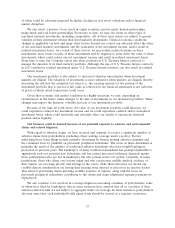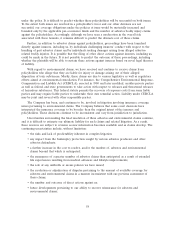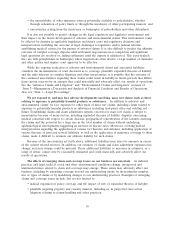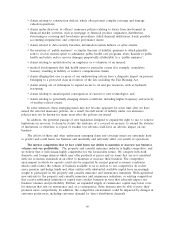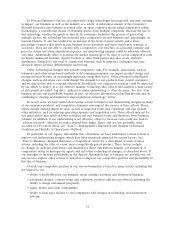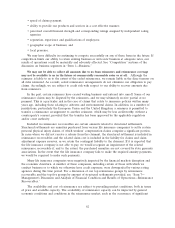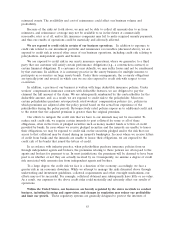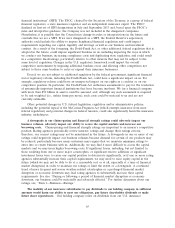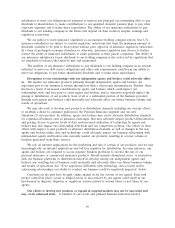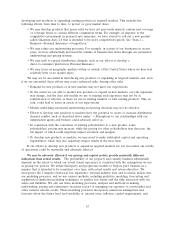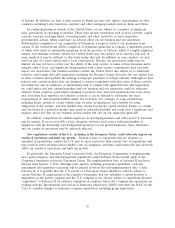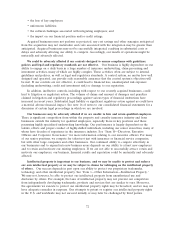Travelers 2013 Annual Report Download - page 74
Download and view the complete annual report
Please find page 74 of the 2013 Travelers annual report below. You can navigate through the pages in the report by either clicking on the pages listed below, or by using the keyword search tool below to find specific information within the annual report.policyholders, and not necessarily the interests of insurers, their shareholders and other investors. For
example, to protect policyholders whose insurance company becomes financially insolvent, guaranty
funds have been established in all 50 states to pay the covered claims of policyholders in the event of
an insolvency of an insurer, subject to applicable state limits. The funding of guaranty funds is provided
through assessments levied against remaining insurers in the marketplace. As a result, the insolvency of
one or more insurance companies could result in additional assessments levied against us.
These regulatory systems also address authorization for lines of business, policyholders’ surplus
requirements, limitations on the types and amounts of certain investments, underwriting limitations,
transactions with affiliates, dividend limitations, changes in control, premium rates and a variety of
other financial and non-financial components of an insurer’s business.
In recent years, the state insurance regulatory framework has come under increased scrutiny, and
some state legislatures have considered or enacted laws that may alter or increase state authority to
regulate insurance companies and insurance holding companies. Further, the NAIC and state insurance
regulators continually re-examine existing laws and regulations, specifically focusing on modifications to
holding company regulations, interpretations of existing laws and the development of new laws and
regulations. The NAIC recently amended the Insurance Holding Company Model Regulation requiring
insurers who are part of a holding company system to complete an enterprise risk report to provide a
summary of the holding company’s enterprise risk management (ERM) framework. It is possible that
our states of domicile will require changes in our ERM process or take other regulatory actions that
could limit our ability to write additional business or require that we hold additional capital. See
‘‘Enterprise Risk Management’’ herein for further discussion of the Company’s ERM.
In a time of financial uncertainty or a prolonged economic downturn or otherwise, regulators may
choose to adopt more restrictive insurance laws and regulations. For example, insurance regulators may
choose to restrict the ability of insurance subsidiaries to make payments to their parent companies or
reject rate increases due to the economic environment. The state insurance regulators may also
increase the statutory capital requirements for our insurance subsidiaries. In addition, state tax laws
that specifically impact the insurance industry, such as premium taxes or other taxes, may be enacted or
changed by states to raise revenues.
State laws or regulations that are adopted or amended may be more restrictive than current laws
or regulations and may result in lower revenues and/or higher costs of compliance and thus could
materially and adversely affect our results of operations and limit our growth.
Changes in federal regulation could impose significant burdens on us and otherwise adversely
impact our results. While the U.S. federal government has not historically regulated the insurance
business, in 2010 the Dodd-Frank Wall Street Reform and Consumer Protection Act (the Dodd-Frank
Act) established a Federal Insurance Office (the FIO) within the U.S. Department of the Treasury. The
FIO has limited regulatory authority and is empowered to gather data and information regarding the
insurance industry and insurers. In December 2013, the FIO released a report recommending ways to
modernize and improve the system of insurance regulation in the United States. While the report did
not recommend full federal regulation of insurance, it did suggest an expanded federal role in some
circumstances. In addition, the report suggested that Congress should consider direct federal
involvement to fill regulatory gaps identified in the report, should those gaps persist, for example, by
considering either establishing a federal coordinating body or a direct regulator of select aspects of the
industry, such as large complex institutions or institutions that seek a federal charter, if a law is passed
to allow a federal charter. It is not clear as to the extent, if any, the report will lead to regulatory
changes or how any such changes would impact the Company.
The Dodd-Frank Act also gives the Federal Reserve supervisory authority over a number of
nonbank financial services holding companies, including insurance companies, if they are designated by
a two-thirds vote of a Financial Stability Oversight Council (the FSOC) as ‘‘systemically important
64





